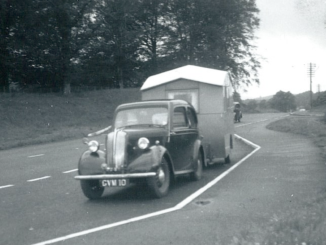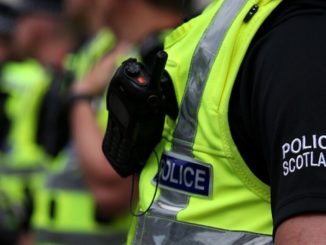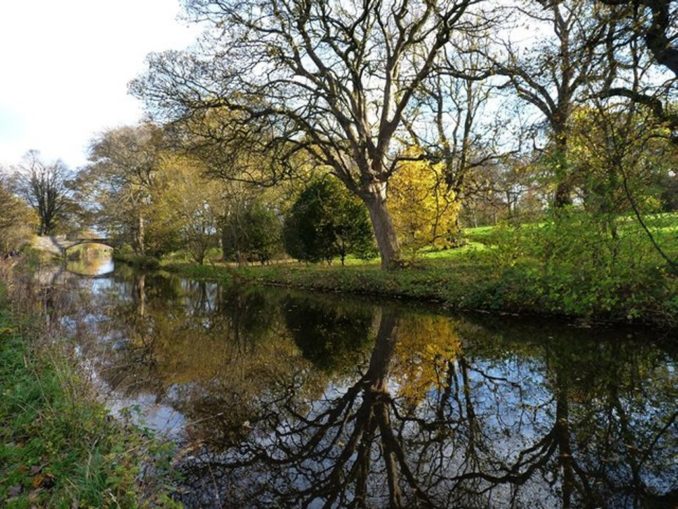
Autumnal reflections (https://www.geograph.org.uk/photo/2710604). © Copyright James Allan and licensed for reuse under this Creative Commons Licence.
Imagine, if you will, that you have decided to go for a horse ride along a canal towpath. You see a canal barge making its way along the canal and in front of the barge is a wave. Do you note the scene and ride on? Perhaps think of heading for a canal-side pub for a spot of lunch? If you do either of these things then you would have missed the opportunity to achieve scientific greatness in developing the theory of Solitons or as Russell described them, the wave of translation..
His ride at Hermiston, close to Heriot Watt University Riccarton campus, was re-enacted in 1995 near to the original spot. They also named the nearby canal viaduct over the Edinburgh by-pass after him.
So, what are Solitons and who was John Scott Russell?
Solitons:
A soliton is a self-reinforcing wave packet that maintains its shape while it propagates at a constant velocity. Solitons are caused by a cancellation of non-linear and dispersive effects in the medium. Solitons are the solutions of a widespread class of weakly non-linear dispersive partial differential equations describing physical systems. (No, me neither). Solitons have three properties:
- They are of a permanent form.
- They are localized within a region.
- They can interact with other solitons and emerge from the collision unchanged, except for a phase shift.
We find solitons in: tidal bores such as those following the undular wave in the river Severn; in undersea internal waves; atmospheric solitons such as the morning glory clouds of the Gulf of Carpentaria. There is also a neuroscience soliton model proposed for signal conduction within neurons.
Solitons study led to improvements in naval architecture w.r.t. hull design of merchant and naval vessels. With the development of computers, soliton theory was significant in parts of physics, electronics, biology and fibre optics.
John Scott Russell:
Born in Parkhead, Glasgow on the 9th May 1808. Died Ventnor, I.O.W 1882.
He graduated from the University of Glasgow in 1825 at the age of 17 and then moved to Edinburgh to teach at the Leith Mechanics’ Institute:
Parkhead is probably better known for being the home of Celtic F.C. Their ground is known as “Paradise” from when a journalist in 1892, covering their move from their old ground across the road, reported it as akin to “moving from the graveyard to paradise” thereby referencing the proximity of the nearby cemetery.
The University of Glasgow is a public research university founded by papal bull in 1451. It is one of Scotland’s four ancient universities, fourth oldest in the English speaking world. Its motto is “Via Veritas Vita”. This translates to “The way, the truth and the life”. Spoken by Jesus Christ in reference to himself, according to the Vulgate version of John 14:6.
To illustrate the modern university: GUMSA is Glasgow University Muslim Students Association, one of the largest societies on campus as well as being the oldest Muslim student organisation in Scotland and one of the oldest in the UK. The university is believed to be the first to pay reparations for slavery (https://www.bbc.com/news/uk-scotland-glasgow-west-49435041).
Famous Alumni were: Adam Smith, James Watt, Lord Kelvin.
Present day Alumni are: Sturgeon, Mhairi Black SNP MP (young alumus of the year 2015), MSP Humza Yousaf Cabinet secretary for Justice. It would seem that driving without insurance (https://tinyurl.com/y52tmwwa) was no bar to him becoming Justice Secretary in the Scottish Parliament.
Mechanics’ Institutes
Such Institutes are educational establishments originally formed to provide adult education in technical subjects to working men. There are thousands still in existence in some shape or form across the Anglosphere. Originally, they provided lending libraries, lectures, laboratories and even a museum. The Glasgow Mechanics’ Institute even provided free light on two evenings a week from the local gas light company. They were often funded by philanthropic industrialists such as Robert Stephenson, Joseph Whitworth, George Birbeck. The Edinburgh Institute became Heriot Watt University; the London Institute became Birbeck College; the Manchester Institute became UMIST. The University of Gloucester has the Cheltenham Mechanics Institute and the Gloucester Mechanics Institute in its timeline. Mention should be made of George Jacob Holyoake, arrested, convicted and jailed in 1842 for blasphemy in a public lecture in the Cheltenham Mechanics Institute. The lecture had no theological character and the incriminating words were in a reply to a question from the body of the meeting. That meeting had moved and carried the motion that “free discussion was equally beneficial in the departments of politics, morals and religion”.plus ça change, plus c’est la même chose.
During 1832-33, following the death of John Leslie, he substituted for the professor of natural philosophy at Edinburgh University; but he did not apply for the vacant post.
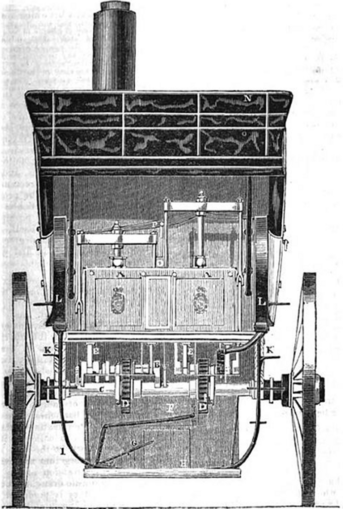
Filehttps://commons.wikimedia.org/wiki/Main_Page. Source The Mechanics’Magazine. vol 22, 28 Feb 1835, p385.
While in Edinburgh JSR experimented with square boiler steam engines. He developed a method of staying the surface of the boiler which became universal. From this, 26 seater steam carriages were developed in March 1834 to run hourly services at 15mph between Glasgow and Paisley. In July 1834 a carriage overturned and the boiler smashed causing the death of several passengers. Two of the coaches were sent to London where they ran for a short time between London and Greenwich. He also conducted research for the Union Canal Company on the feasibility of steam powered canal barges and studied the connection between resistance to motion and wave generation. This work was discussed at The British Association for The Advancement of Science and they appointed him and Sir John Robinson to a “Committee on Waves”.
JSR determined ship hull shapes that would give the least resistance. It wasn’t just a case of cutting through the water but also of getting the water to come back in around the stern. He validated his belief that a “versed sine wave” produced the ideal shape.
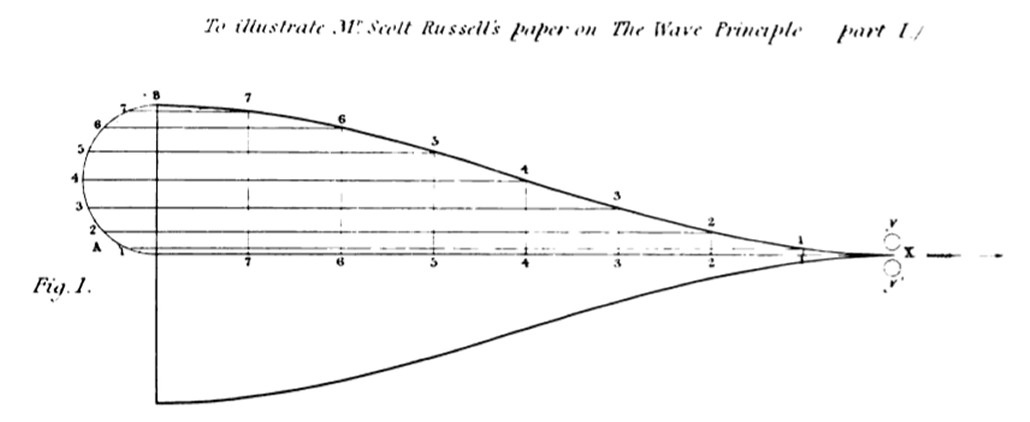
John Scott Russell, Public domain, via Wikimedia Commons
Most ships had a rounded bows to maximize cargo stowage but from the 1840s ships started to have concave bows. He moved to London in 1844 and as secretary for the Royal Society of Arts stimulated the idea of having a national exhibition, this became the Great Exhibition of 1851 He also continued to design yachts, boats, barges and ships. In 1850 he designed the yacht Titania for Robert Stevenson which had very hollow bow lines. The following year Titania was the only vessel to accept the challenge from US yacht America, her defeat inaugurated the America cup races. Russell, whilst director of a Millwall shipyard, became a partner of Brunel’s on the Great Eastern. The pair disagreed on a range of design and construction issues. Even on how to eventually launch the ship. JSR favoured a dry dock to built and float it whereas Brunel prevailed in having a slipway. JSR was proved to be right as the steam winches struggled to actually move the Great Eastern. Russell also built the iron warship Warrior.
Russell was a better engineer than he was a businessman and he was plagued with financial difficulties. He was convicted of assaulting a solicitor’s clerk. This concerned a foreclosure order to seize the house and estate for the Land Securities company. He was fined £10 and bound over to keep the peace. In 1879 his possessions were sold at auction. He died in 1882 at Ventnor I.O.W. His wife had a somewhat gruesome death in Ventnor in 1888 when at the age of 80 she fell into the firegrate of the room.
JSR’s engineering career: Royal Society of Edinburgh (Councillor 1838-9), Royal Society, institution of Civil engineers (Vice President), Institute of Naval Architects (Vice President), Society of Arts (Secretary 1845-50).
References:
Wikipedia.
Gracie’s Guide to British Industrial History. “To ensure the work receives the widest usage, all material is published freely and without any claim to copyright by Grace’s Guide”
https://mathshistory.st-andrews.ac.uk/Biographies/Russell_Scott/ . Creative Commons Attribution-ShareAlike 4.0 International License.
© Martianonlooker 2021
The Goodnight Vienna Audio file
Audio Player

